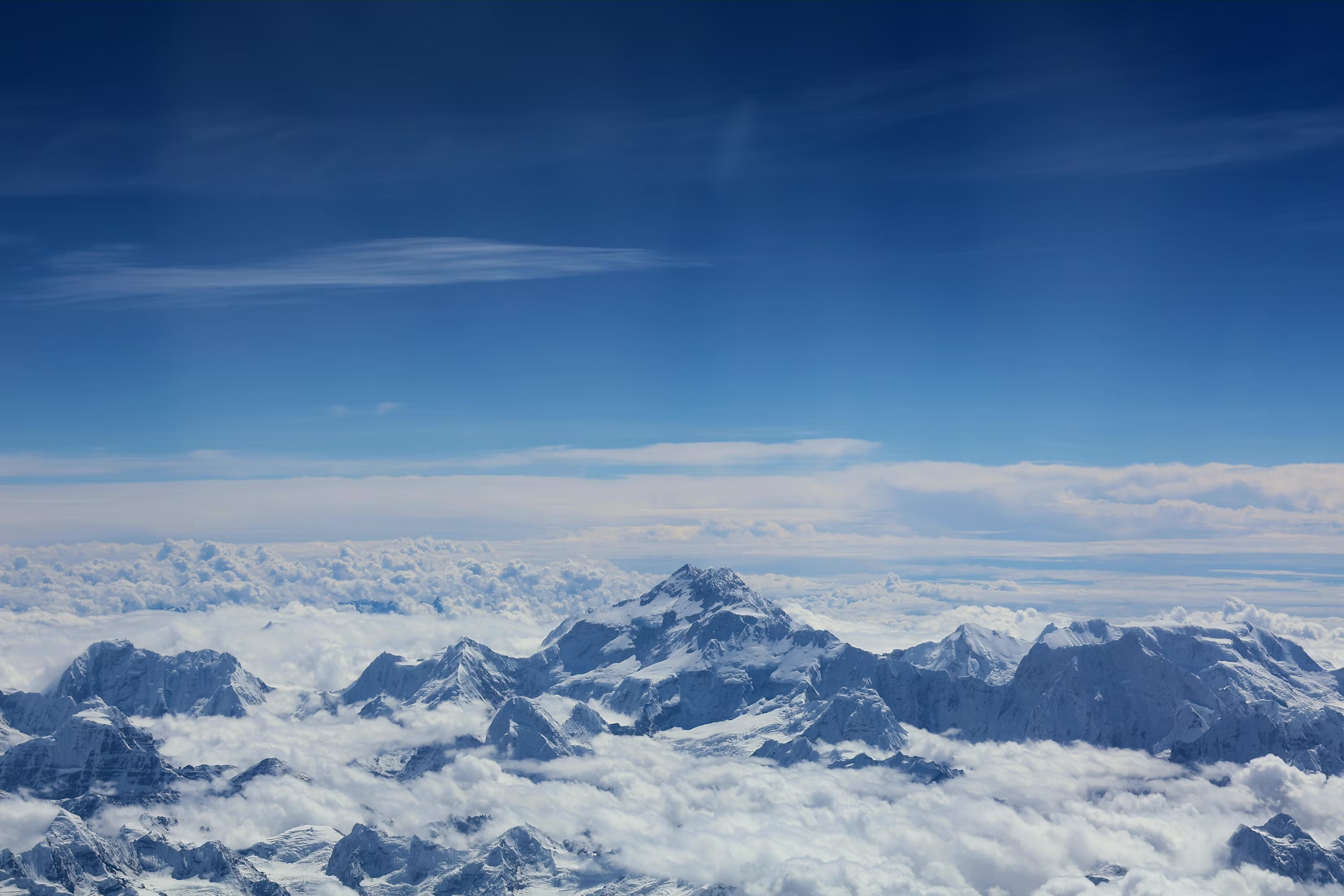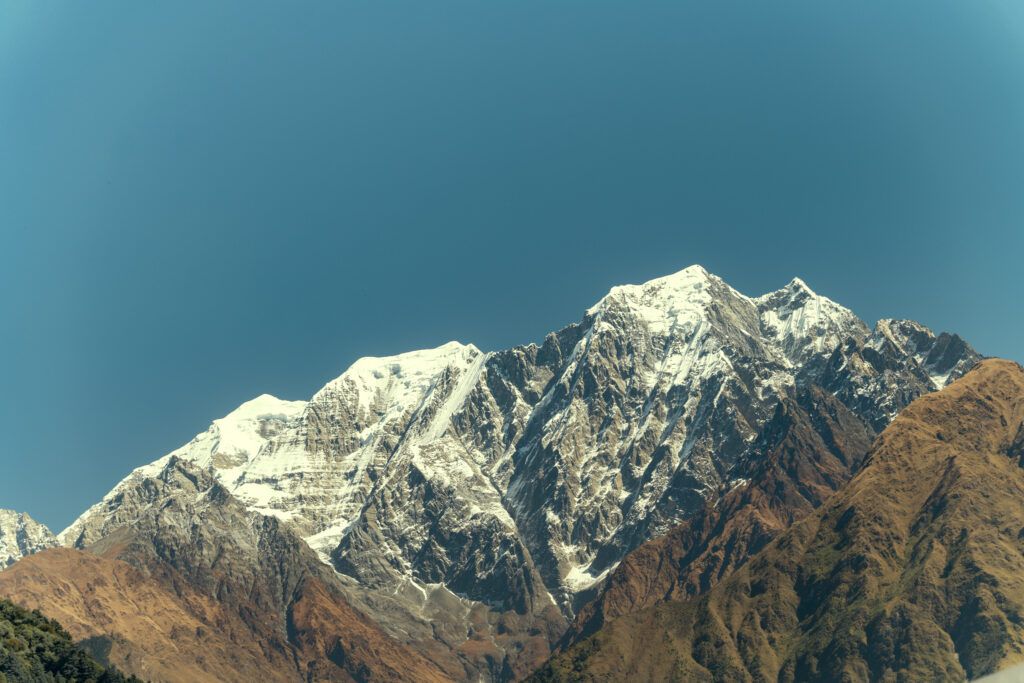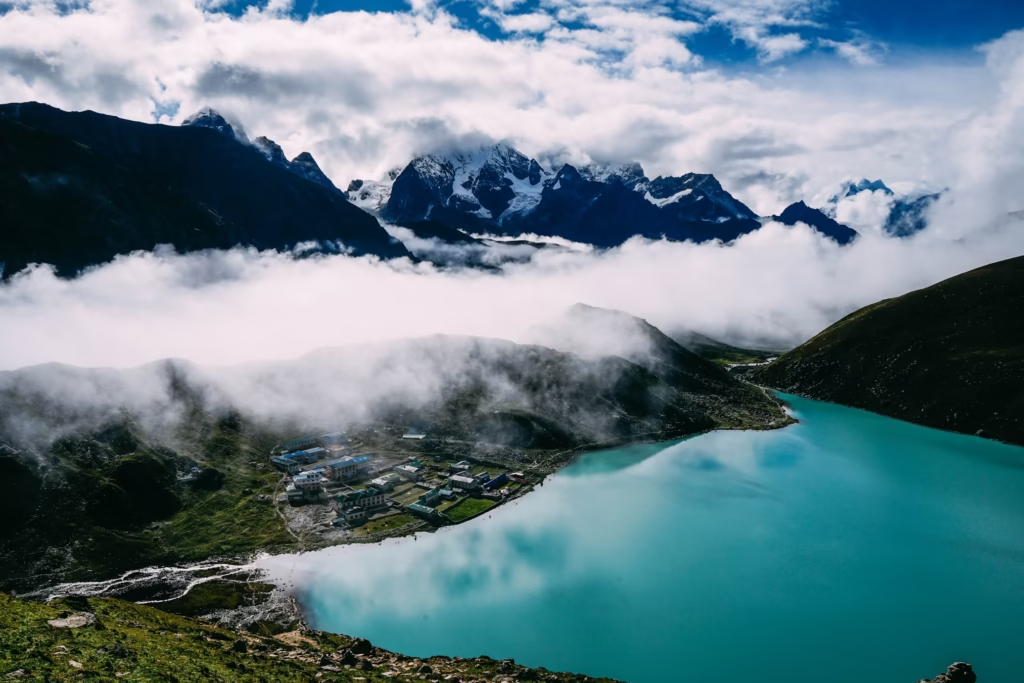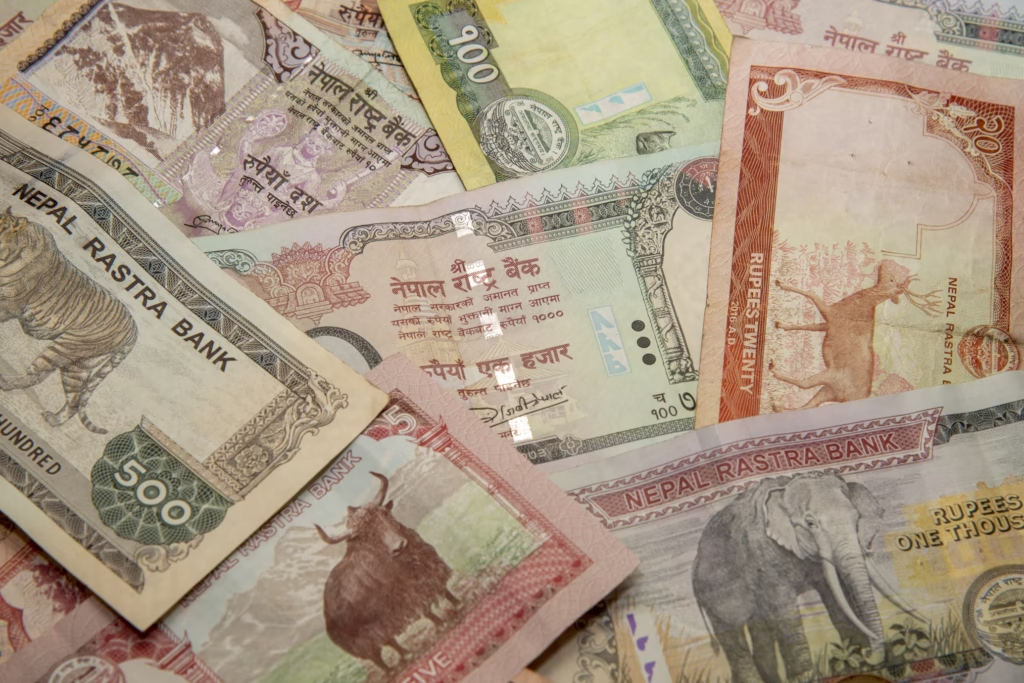
Walking to Everest Base Camp trekking is a dream for many people around the world. It’s not just a trek — it’s a journey through the beautiful mountains of Nepal, small Sherpa villages, and peaceful valleys. Every step brings you closer to Mount Everest, the highest mountain in the world. You don’t need to be a climber to see it. Just strong legs, a good spirit, and a bit of planning. The trek takes you through forests, across swinging bridges, and up to high mountain paths.
You meet friendly locals, eat warm meals in cozy teahouses, and sleep under bright starry skies. The air gets thinner as you go higher, but the views become more amazing each day. From snow-covered peaks to prayer flags blowing in the wind — the Everest Base Camp trekking is full of adventure, beauty, and memories you’ll never forget.
Introduction of Mt. Everest
Mount Everest, known as Sagarmatha in Nepal and Chomolungma in Tibet, is the highest mountain in the world, towering at an incredible 8,848.86 meters (29,031.7 feet) above sea level. Standing tall in the heart of the Himalayas, it has captured the imaginations of adventurers for centuries. The mountain is part of the mighty Everest Massif, located on the border between Nepal and Tibet. Its peak is a symbol of human endurance, strength, and the never-ending quest to conquer nature’s greatest challenges.
While summiting Everest is an achievement few can claim, the journey to its base camp is a stunning adventure accessible to anyone with the right spirit. Trekking to Everest Base Camp gives you the unique opportunity to get up close to this mighty peak without the dangers of high-altitude climbing.
The Shrepas : Everest Base Camp Trekking
For the Sherpa people, Everest holds deep cultural and spiritual significance. The mountain is more than just a physical challenge; it’s part of their heritage and faith. Local legends speak of the mountain as the home of gods and a place of spiritual energy. The Sherpas, known for their incredible strength and resilience, have been guiding trekkers and climbers for decades, helping them navigate the rugged terrain and harsh conditions. Everest Base Camp trekking itself is a bustling hub for climbers, with dozens of teams making their final preparations before attempting the summit. For trekkers, it’s a chance to experience the beauty and mystique of Everest from a safe distance, with the mountain towering above them.

Despite its popularity, Everest is still a dangerous and unpredictable force of nature. The weather can change rapidly, and trekkers must be prepared for cold temperatures, strong winds, and high-altitude challenges. The mountain itself is shrouded in myths, with stories of ghosts, ancient spirits, and the struggle for survival surrounding it. Yet, Everest continues to draw thousands of trekkers every year who seek the thrill of seeing the mountain up close. As you make your way to Base Camp, the majesty of Everest becomes even more awe-inspiring — its glaciers, snowfields, and towering cliffs fill your view. It’s not just the height of Everest that leaves you breathless, but the sheer beauty and raw power that define this extraordinary mountain.
Everest Base Camp Weather, Altitude & Best Time to Trek
The climate in the Everest region is shaped by its high altitude, which means the weather can be unpredictable, with sharp contrasts between seasons. In the lower altitudes, the trek starts in lush forests with mild temperatures, but as you gain altitude, the air becomes thinner, and the weather grows colder. The best time to visit is during the two main trekking seasons — spring (March to May) and autumn (September to November).
During these months, the weather is generally stable, with clear skies, moderate temperatures, and breathtaking views. Daytime temperatures can range from 10°C to 15°C (50°F to 59°F) at lower elevations, but at higher altitudes, the temperatures drop significantly. Nights can be freezing, especially as you approach Base Camp, with temperatures plunging to -10°C to -15°C (14°F to 5°F).

Best Time to Trek
However, Everest Base Camp trekking during the monsoon season (June to August) or the winter months (December to February) can be challenging and risky. The monsoon brings heavy rains, making trails slippery and prone to landslides, especially at lower elevations. The winter months are even harsher, with temperatures dropping well below freezing at night and unpredictable snowstorms that can block the path to Base Camp.
During these times, visibility is poor, and the risk of altitude sickness increases, as the colder weather and reduced oxygen make acclimatization more difficult. While the scenery during winter can be stunning with snow-covered peaks, it’s much harder to enjoy the trek in such harsh conditions. Avoiding these extreme seasons is crucial for a safer and more enjoyable experience.
At high altitudes, trekkers face the challenge of low oxygen levels, which can cause altitude sickness. The air pressure decreases the higher you go, leading to symptoms like headaches, dizziness, nausea, and shortness of breath. To minimize risks, trekkers must follow a gradual ascent schedule, allowing their bodies time to acclimatize to the changing conditions. Proper hydration, rest, and eating well are essential to cope with the altitude. Sudden changes in weather are also a major hazard — the Everest region is known for its strong winds, sudden snowstorms, and the risk of avalanches, especially in the higher reaches above 4,500 meters (14,763 feet). Being prepared for these unpredictable elements is key to enjoying the trek safely.
Everest Base Camp Trek Route, Duration, Packing List & Expert Tips
The most popular Everest Base Camp trekking route starts with a short flight from Kathmandu to Lukla, a small mountain town. Lukla has a thrilling runway. From there, the trek passes through villages like Phakding, Namche Bazaar, Tengboche, Dingboche, and Gorakshep. Most treks take 12 to 14 days—about 8 days up and 4 days down, including rest for acclimatization. The highest point is Kala Patthar (5,545 meters), offering stunning sunrise views of Everest. Alternate routes include the Gokyo Lakes trek and the Three Passes trek, which are longer and less crowded. These paths offer more remote beauty but need stronger fitness and more days.

Trekking to Everest Base Camp trekking doesn’t require technical climbing skills, but it does demand good physical fitness and mental strength. A regular walking habit and some uphill training before the trek can help a lot. Essential items to pack include good trekking boots, warm layered clothing, a down jacket, gloves, a hat, sunglasses, sunscreen, and a headlamp. A sleeping bag rated for cold temperatures, reusable water bottle, water purification tablets, and basic medicines are also important. It’s best to carry snacks, trekking poles, and a power bank, since charging is limited and expensive at higher altitudes. Travel insurance that covers high-altitude trekking and emergency evacuation is a must.
Helpful Tips
Some helpful tips in Everest Base Camp Trekking can make your journey smoother and safer. Always walk at your own pace and never rush uphill — slow and steady is the key to avoiding altitude sickness. Drink plenty of water, avoid alcohol, and take rest days seriously for proper acclimatization. Hiring a local guide or porter not only supports the community but also makes the trek easier and more enjoyable.
Teahouses along the route offer basic meals and rooms, but they get colder and more crowded as you go higher — booking in advance during peak season is smart. Cash is king in the mountains, so carry enough Nepalese rupees for food, accommodation, and small purchases. Most importantly, respect the local culture, greet people with a warm “Namaste,” and leave no trash behind — the mountains deserve our care.
Hidden gems of Everest Region
Khumjung Village : Everest Base Camp Trekking
One of the most special hidden gems during Everest Base Camp trekking is Khumjung Village, tucked quietly above Namche Bazaar. It’s a peaceful Sherpa village with fewer tourists, stunning views, and a real sense of local life. The village is home to the Khumjung Monastery, which claims to house a yeti scalp — a unique and curious sight for trekkers. Nearby, you can also visit the Hillary School, built by Sir Edmund Hillary to support education in the region. The whole area gives you a deep cultural experience away from the busier trails. If you’re staying an extra night in Namche, a side trip here is truly worth it.
Tengboche Monastery : Everest Base Camp Trekking
Another quiet treasure while Everest Base Camp trekking is the Tengboche Monastery, one of the most spiritual places on the trek. Surrounded by panoramic views of Ama Dablam, Everest, and other peaks, the monastery sits like a peaceful guardian of the mountains. If you arrive in the afternoon, you can witness the monks chanting during evening prayers, a calming and powerful moment many miss. This spot is not just about scenery — it brings a deep sense of peace in the middle of the tough journey. The small bakery nearby is also a pleasant surprise, serving warm apple pies and coffee with an unbeatable view. Most trekkers pass through quickly, but staying a bit longer makes the visit more meaningful.

Gokyo Lakes : Everest Base Camp Trekking
For those who have time and energy for a detour, the Gokyo Lakes route is an absolute gem in Everest Base Camp trekking. These high-altitude glacial lakes shine bright turquoise, surrounded by snow-covered peaks and quiet trails. The viewpoint at Gokyo Ri offers one of the best panoramas in the entire Everest region — many say it’s even better than Kala Patthar. This route is less crowded than the main EBC trail, giving you a more peaceful and off-the-beaten-path experience. You’ll also cross the Ngozumpa Glacier, the largest glacier in Nepal. It’s a tougher route and takes a few more days, but for nature lovers, it’s a hidden paradise well worth the effort.
Sherpa Culture & Traditions on the Everest Base Camp Trek
The Everest region is home to the Sherpa people, known for their warm hospitality, strength, and deep connection to the mountains. Most Sherpas follow Tibetan Buddhism, and you’ll see this influence everywhere — in the spinning prayer wheels, colorful prayer flags, and sacred stupas along the trail. Every village has a mani wall with carved stones, and it’s tradition to walk past them on the left as a sign of respect. Many trekkers are surprised by how spiritual the journey feels, even before reaching the high mountains. The Sherpa culture teaches balance with nature and respect for all living things. It’s a peaceful way of life that adds something truly special to the trek.
In places like Namche Bazaar, Pangboche, and Dingboche, you’ll get a chance to experience daily Sherpa life. Locals farm on steep hillsides, raise yaks, and run small lodges that serve hot meals to trekkers. You may hear monks chanting softly or see families gathered around fires in the evening. Though remote, Sherpa people are kind and resourceful, always ready to help with a smile. Traditional foods like dal bhat, tsampa, and yak butter tea offer a true taste of mountain life. Sharing a meal in a family-run teahouse is one of the most heartwarming parts of the trek.
Festivals : Everest Base Camp Trekking
Festivals are another way to connect with the local culture, and if you’re lucky, you might witness one. The Mani Rimdu Festival, held at Tengboche Monastery, is the biggest religious celebration in the region. It features masked dances, prayers, and rituals to drive away evil and bring blessings to the community. It usually takes place in October or November, and locals from many villages come to attend. The energy during these festivals is joyful, with music, traditional dress, and strong community spirit. Experiencing a Sherpa festival in the high mountains is something you’ll remember forever — it’s a rare window into a culture that lives in harmony with the world’s highest peaks.
Everest Base Camp Trek Cost, Permits & Travel Arrangements
The cost of the Everest Base Camp trekking can vary depending on how you plan it. On average, the total cost ranges from $1,200 to $2,000 USD for a 12–14 day trek, including flights, permits, food, guide/porter, and accommodation. A guided package is easier and safer for first-timers, and it usually covers everything from airport pickup to meals on the trail. If you prefer to go independently, you can save money, but you’ll need to arrange flights, permits, and lodges yourself. Don’t forget to budget extra for tips, snacks, charging electronics, and hot showers, which cost more the higher you go. Always carry enough cash in Nepalese rupees, as there are no ATMs after Namche Bazaar.
Formalities : Everest Base Camp Trekking
Before starting the Everest Base Camp trekking, there are a few formalities to complete. You’ll need two main permits — the Sagarmatha National Park Entry Permit and the Khumbu Pasang Lhamu Rural Municipality Permit. These can be arranged in Kathmandu or in Monjo at the park entrance, and they cost around NPR 5,000–6,000 (about $40–45 USD) total.
If you’re flying to Lukla, make sure to book your flights early, especially during peak seasons, as they fill up quickly. Travel insurance that covers trekking up to 6,000 meters and emergency evacuation by helicopter is strongly recommended. It’s also helpful to register your trek with local authorities or your embassy for safety reasons. A little planning goes a long way in making your Everest adventure smooth and stress-free.

Conclusion : Everest Base Camp Trekking
Trekking to Everest Base Camp is more than just a walk in the mountains — it’s a journey through breathtaking landscapes, rich culture, and personal growth. You’ll pass through peaceful Sherpa villages, cross high suspension bridges, and walk beside towering peaks that seem to touch the sky. Along the way, you’ll learn to slow down, breathe deeper, and take in the beauty that surrounds you.
The trail is not always easy, but every step brings something new — a kind smile, a warm cup of tea, or a view that stays with you forever. From the excitement of Lukla to the quiet magic of Base Camp, every part of the trek leaves a lasting mark on your heart. It’s an experience that changes how you see the world — and yourself.
To make your Everest base camp trekking safe and unforgettable, remember a few simple tips. Go slow, listen to your body, and always stay hydrated — altitude sickness is real and must not be ignored. Pack light, but don’t forget the warm gear and good boots. A guide or porter can make a big difference, both for your safety and for supporting the local community. Respect the culture, leave no trash, and greet people with a kind “Namaste” — small gestures mean a lot in the mountains. And most of all, enjoy the journey — it’s not just about reaching Base Camp, but everything you experience along the way.

